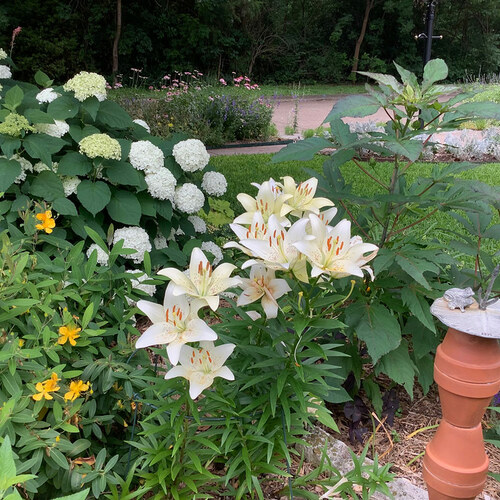
Hi GPODers! Today we’re in Sharon Holmes’ Dallas garden that faces its fair share of obstacles and challenging conditions. Despite punishing weather, clay soil, and a whole host of wildlife and insects that visit her garden, there are plenty of plants that have survived and even thrived.
I’ve been gardening at my home in east Dallas Texas for 29 years, although I’m not sure the first 5 really count as anything but hard lessons. I’m submitting views of my front garden in April, May, and now June. And a few vignettes of combos that came out nice this year.
Dallas has its own ideas of what will grow here as a Zone 8b, and my primary garden struggles are with clay soil, severe heat, and unlimited bugs. This year has been exceptionally wet, with several violent storms. The last one left us without power for 6 days, and downed trees all over the city.
My ambition is to have something interesting going on in my garden from spring to winter. We live on a parkway with a dry creek and lots of tall pecan and oaks. We get lots of critters—possums, raccoons, squirrels, coyotes, cottontails, and an occasional bobcat. The bird list is long. We’ve lost most of our backyard trees to storms over the years, but the front has a large eastern red cedar (Juniperus virginiana, Zones 2–9) and a ginormous southern magnolia (Magnolia grandiflora, Zones 2–9) that have survived it all.
Early April under the cedar. The daffodils have finished, the grass starting to green. Flirt™ nandina (Nandina domestica ‘Murasaki’, Zones 6–10) has great red spring color, Spanish bluebells (Hyacinthoides hispanica, Zones 3–8) are scattered, as is ‘May Night’ salvia (Salvia x sylvestris ‘May Night’, Zones 4–8). The ‘Texas Gold’ columbine (Aquilegia chrysantha hinckleyana ‘Texas Gold’, Zones 3–8) has started blooming, and the ‘Pistachio’ heucheras (Heuchera ‘Pretty Pistachio’, Zones 4–9) are a bright spot under the cedar.
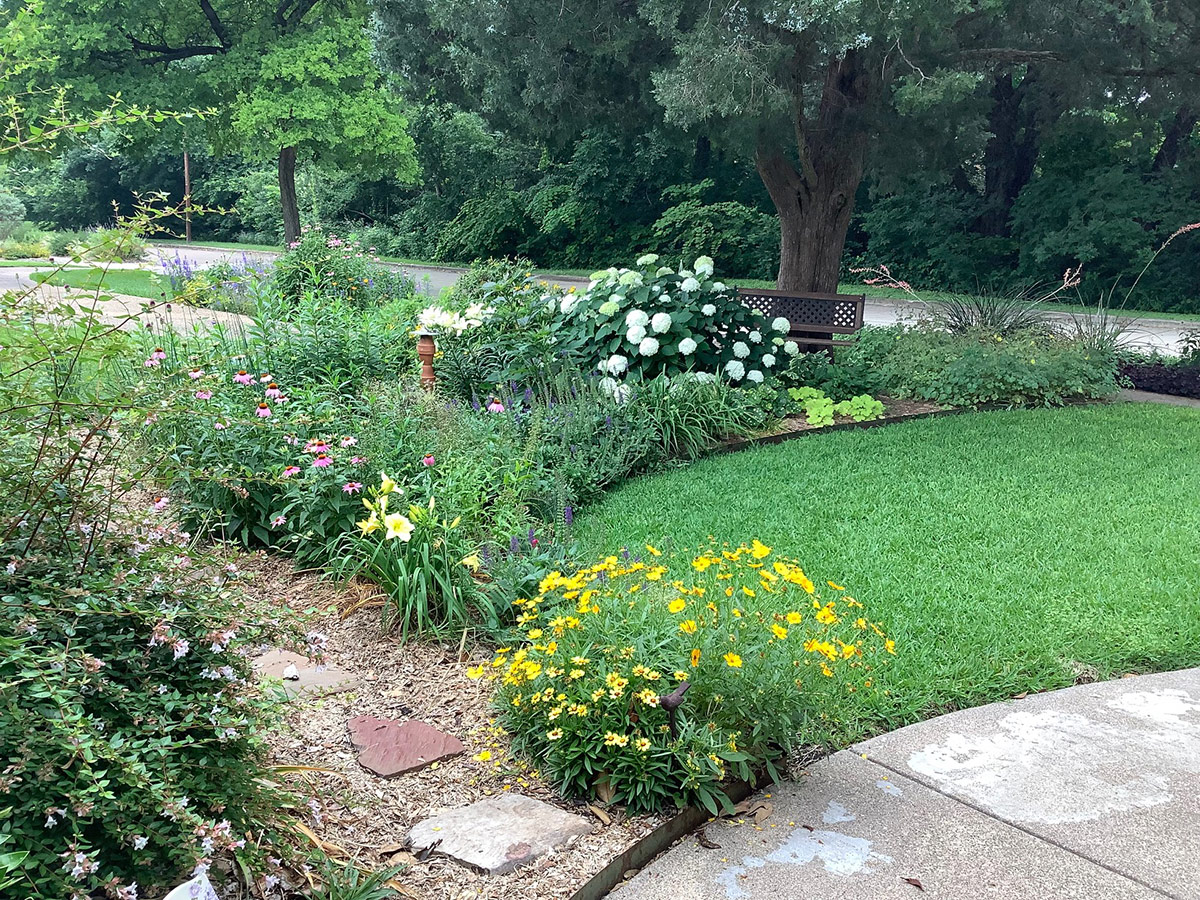 Same area in May. ‘Annabelle’ hydrangea (Hydrangea arborescens ‘Annabelle’, Zones 3–9), ‘Casa Blanca’ lily (Lilium ‘Casa Blanca’, Zones 4–9), coneflower (Echinacea purpurea ‘Magnus’, Zones 3–8), ‘Happy Days’ daylily (Hemerocallis ‘Happy Days’, Zones 3–9), 2 different coreopsis, and an ‘Edward Goucher’ abelia (Abelia ‘Edward Goucher’, Zones 6–9).
Same area in May. ‘Annabelle’ hydrangea (Hydrangea arborescens ‘Annabelle’, Zones 3–9), ‘Casa Blanca’ lily (Lilium ‘Casa Blanca’, Zones 4–9), coneflower (Echinacea purpurea ‘Magnus’, Zones 3–8), ‘Happy Days’ daylily (Hemerocallis ‘Happy Days’, Zones 3–9), 2 different coreopsis, and an ‘Edward Goucher’ abelia (Abelia ‘Edward Goucher’, Zones 6–9).
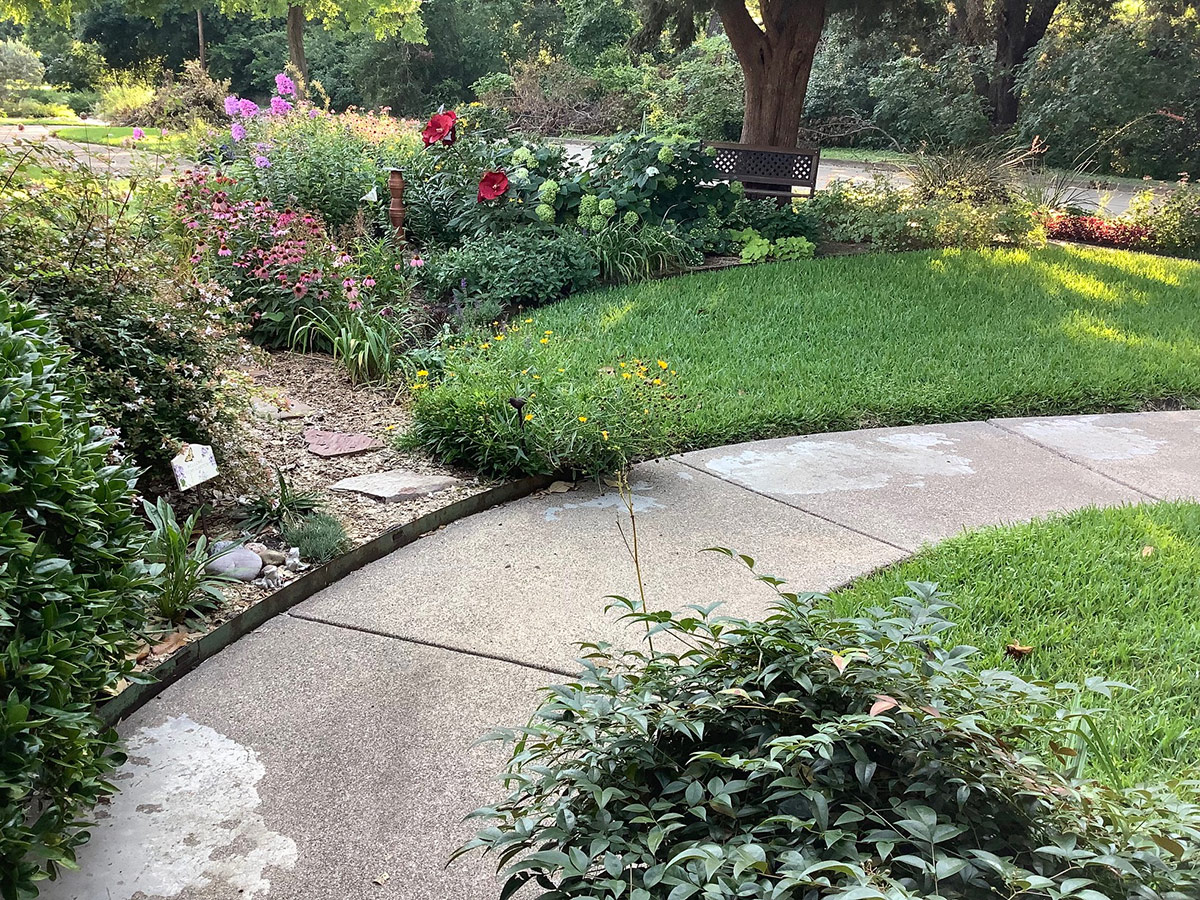 Same area in June. ‘Annabelle’ got whacked by the storm, broken tree limbs still on the parkway. ‘Midnight Marvel’ hardy hibiscus (Hibiscus ‘Midnight Marvel’, Zones 4–9), a rouge phlox descendant of ‘David’ (Phlox paniculata ‘David’, Zones 4–8).
Same area in June. ‘Annabelle’ got whacked by the storm, broken tree limbs still on the parkway. ‘Midnight Marvel’ hardy hibiscus (Hibiscus ‘Midnight Marvel’, Zones 4–9), a rouge phlox descendant of ‘David’ (Phlox paniculata ‘David’, Zones 4–8).
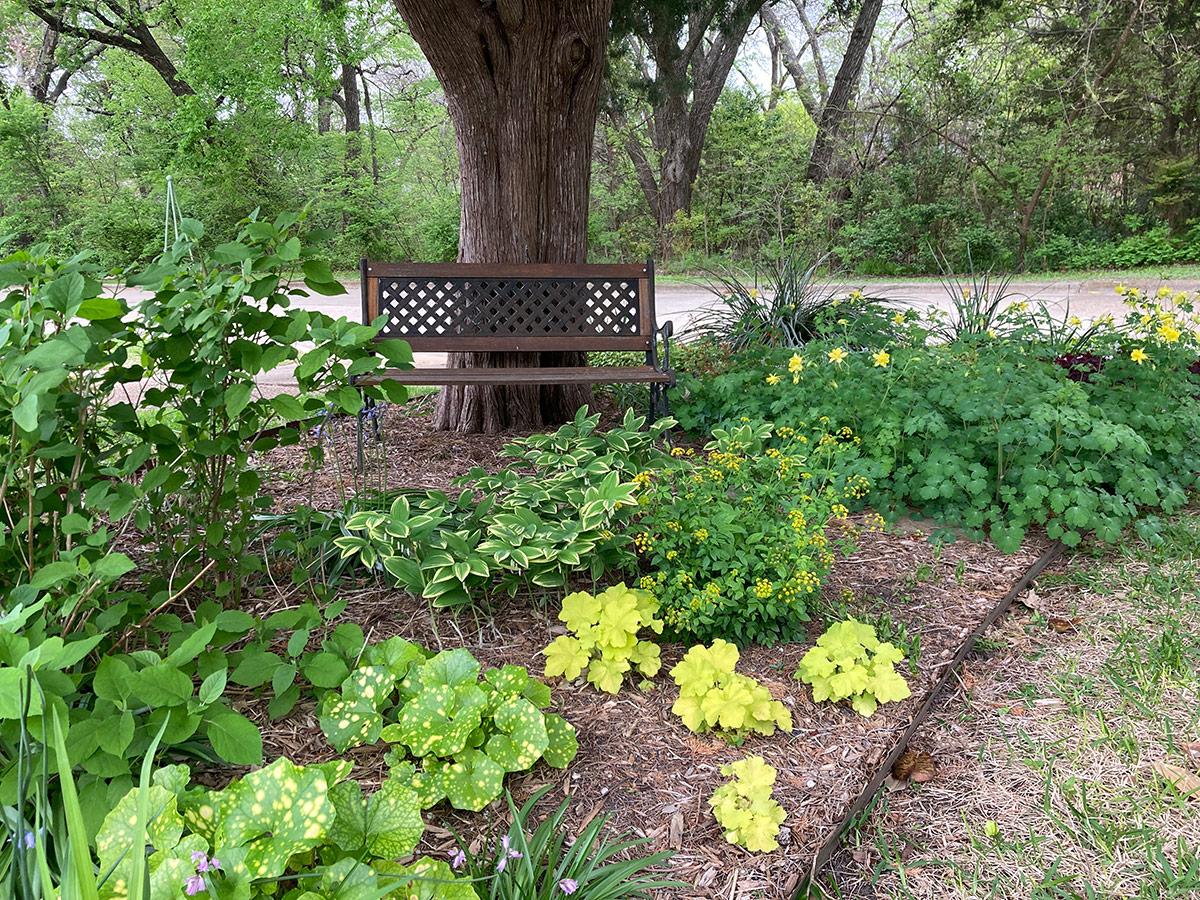 April near the bench. ‘Annabell’ is leafing out, leopard plant (Farfugium japonicum, Zones 7–10), variegated Solomon’s seal (Polygonatum falcatum ‘Variegatum’, Zones 4–8), golden alexander (Zizia aurea, Zones 3–8), ‘Pistachio’ heuchera, and ‘Texas Gold’ columbine.
April near the bench. ‘Annabell’ is leafing out, leopard plant (Farfugium japonicum, Zones 7–10), variegated Solomon’s seal (Polygonatum falcatum ‘Variegatum’, Zones 4–8), golden alexander (Zizia aurea, Zones 3–8), ‘Pistachio’ heuchera, and ‘Texas Gold’ columbine.
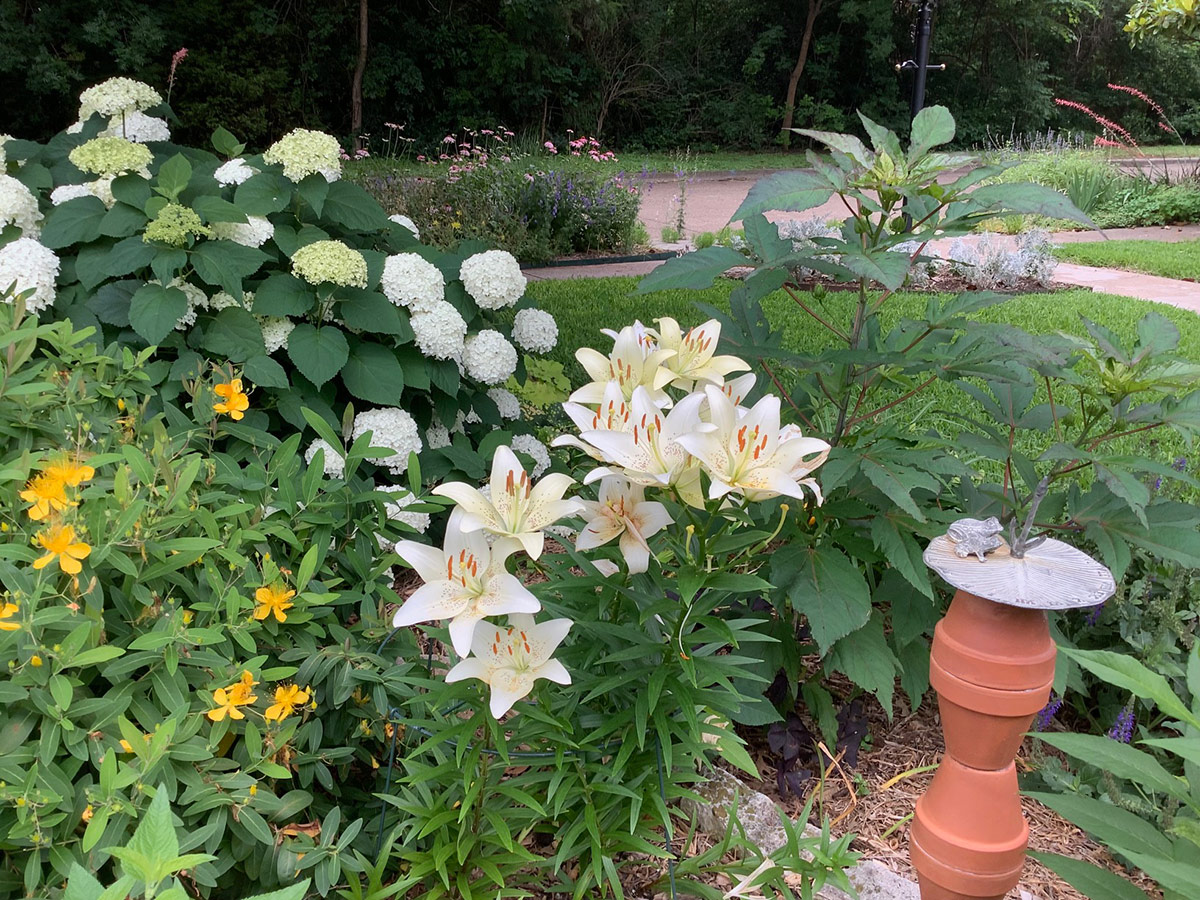 ‘Annabell’, ‘Casa Blanca’ lilies, Henryi St John’s wort (Hypericum henryi ssp. uraloides, Zones 5–9), and ‘Midnight Marvel’ foliage. Red yucca (Hesperaloe parviflora, Zones 5–10), coneflowers, and mealy sage (Salvia farinacea, Zones 8–10) on the hellstrip.
‘Annabell’, ‘Casa Blanca’ lilies, Henryi St John’s wort (Hypericum henryi ssp. uraloides, Zones 5–9), and ‘Midnight Marvel’ foliage. Red yucca (Hesperaloe parviflora, Zones 5–10), coneflowers, and mealy sage (Salvia farinacea, Zones 8–10) on the hellstrip.
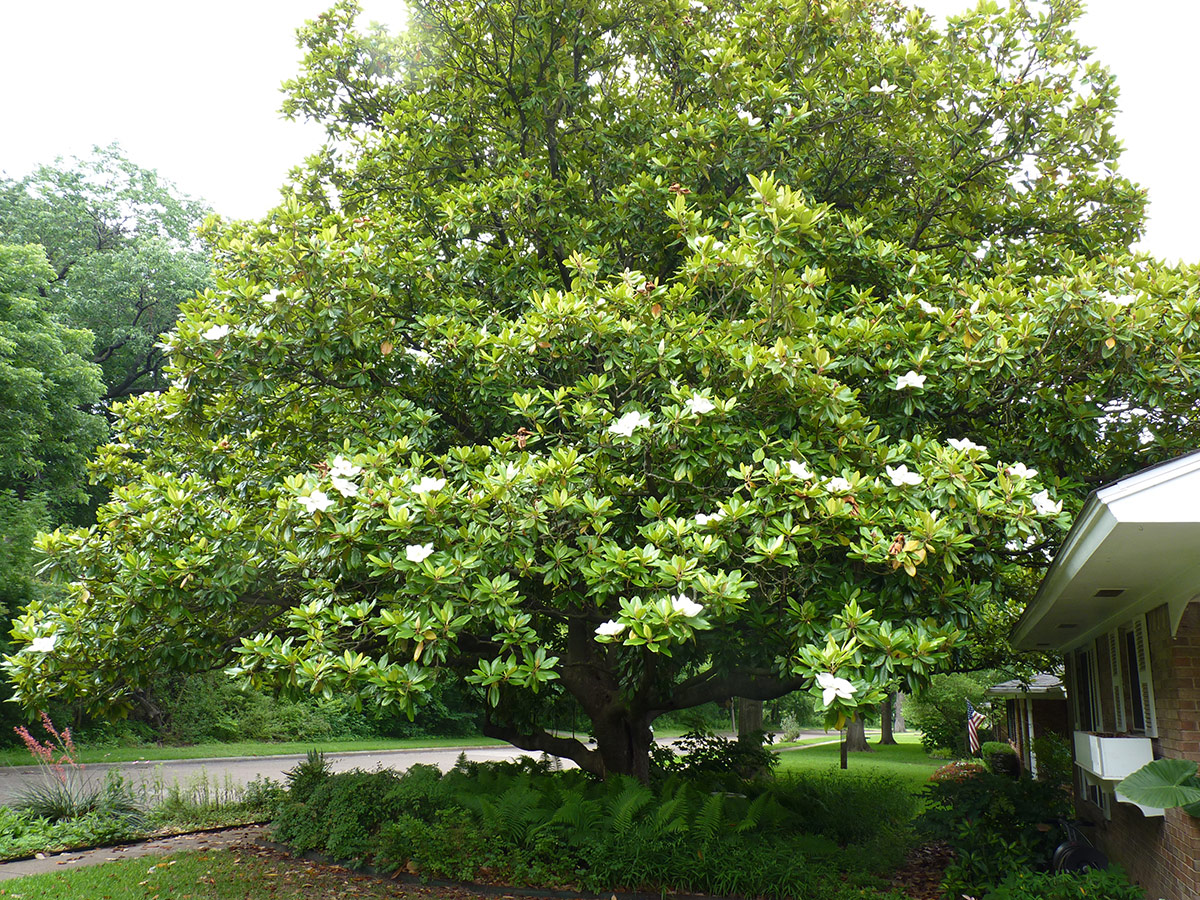 The magnolia, wood fern and inland sea oats (Chasmanthium latifolium, Zones 5–9) battle it out underneath this guy.
The magnolia, wood fern and inland sea oats (Chasmanthium latifolium, Zones 5–9) battle it out underneath this guy.
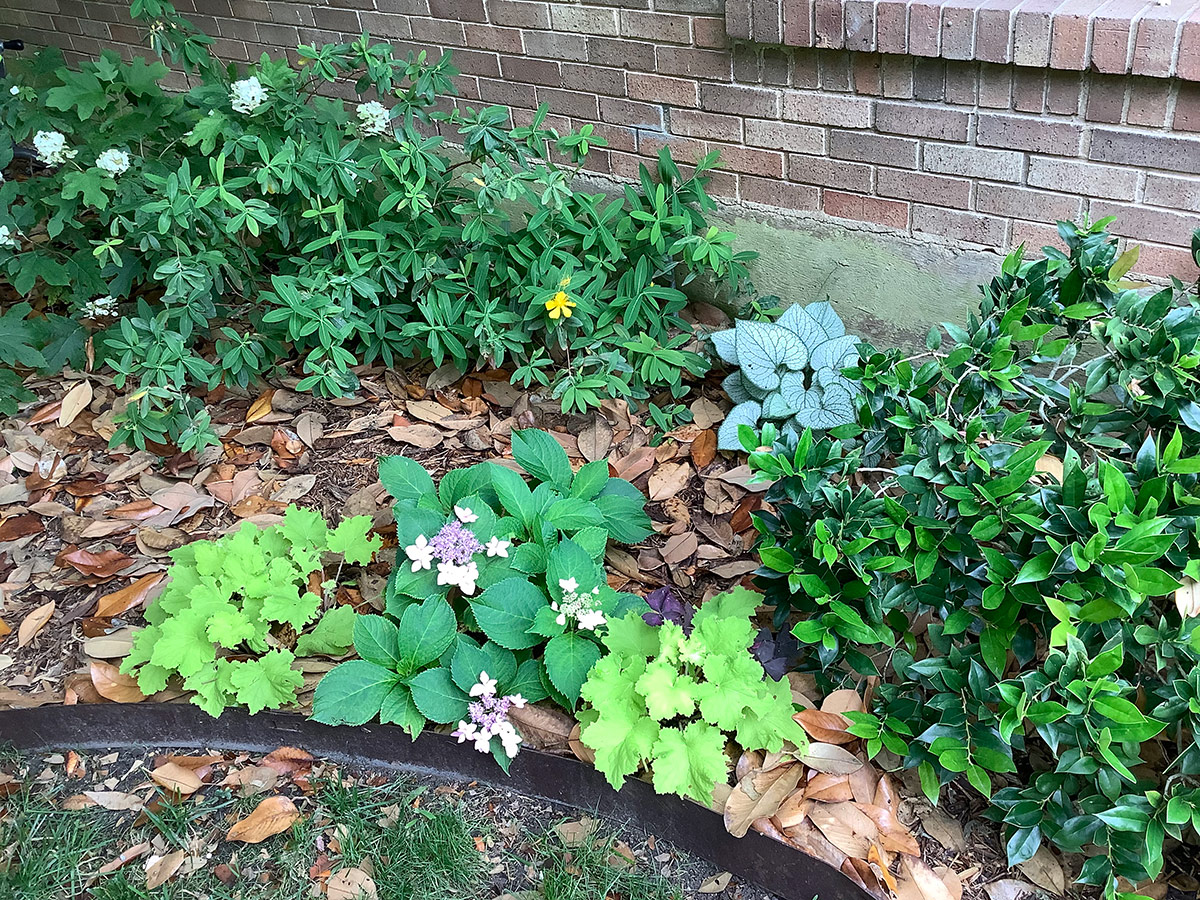 Two years back I cleared out some sad burford hollies (Ilex cornuta, Zones 7–9) under the magnolia. dwarf oakleaf hydrangea (Hydrangea quercifolia, Zones 5–9), St. John’s wort, ‘Sea Heart’ brunnera (Brunnera macrophylla ‘Sea Heart’, Zones 3–9), ‘Pistachio’ heuchera, Tuff Stuff Ah-Ha® hydrangea (Hydrangea serrata ‘SMNHSDD’ TUFF STUFF AH-HA, Zones 5–9), and an older ‘Carissa’ holly (Ilex cornuta ‘Carissa’, Zones 7–9), and magnolia leaves. So. Many. Magnolia. Leaves.
Two years back I cleared out some sad burford hollies (Ilex cornuta, Zones 7–9) under the magnolia. dwarf oakleaf hydrangea (Hydrangea quercifolia, Zones 5–9), St. John’s wort, ‘Sea Heart’ brunnera (Brunnera macrophylla ‘Sea Heart’, Zones 3–9), ‘Pistachio’ heuchera, Tuff Stuff Ah-Ha® hydrangea (Hydrangea serrata ‘SMNHSDD’ TUFF STUFF AH-HA, Zones 5–9), and an older ‘Carissa’ holly (Ilex cornuta ‘Carissa’, Zones 7–9), and magnolia leaves. So. Many. Magnolia. Leaves.
Thank you for sharing your garden with us, Sharon—I would never guess a garden looking this lush is dealing with the challenges you face!
Have a garden you’d like to share?
Have photos to share? We’d love to see your garden, a particular collection of plants you love, or a wonderful garden you had the chance to visit!
To submit, send 5-10 photos to [email protected] along with some information about the plants in the pictures and where you took the photos. We’d love to hear where you are located, how long you’ve been gardening, successes you are proud of, failures you learned from, hopes for the future, favorite plants, or funny stories from your garden.
Have a mobile phone? Tag your photos on Facebook, Instagram or Twitter with #FineGardening!
Do you receive the GPOD by email yet? Sign up here.





